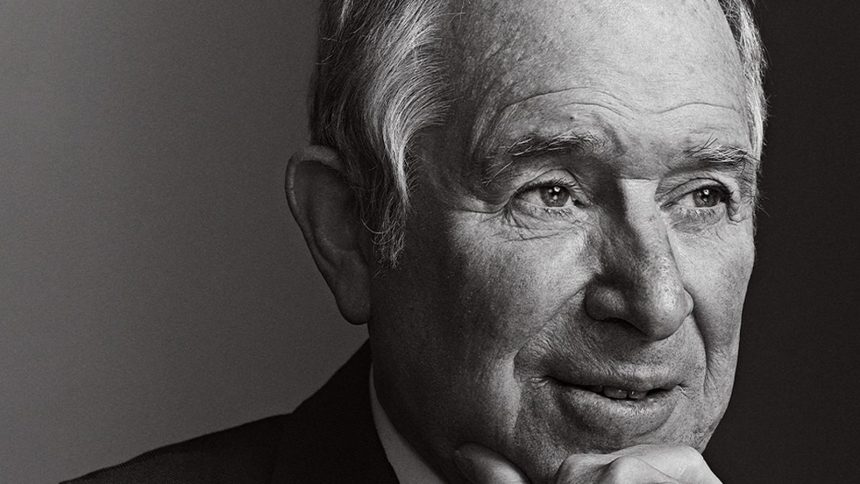Steve Schwarzman’s guiding philosophy has always been to “go big,” and despite Blackstone having surpassed $1 trillion in assets, he’s still feeling expansive.
By Sergei Klebnikov, Forbes Staff
Blackstone’s 77-year old founder and chief executive grew up in a suburb of Philadelphia. From as early as ten-years-old, he would work at his father’s curtains and linens store by helping work the counter. By age 14, he ran his own lawn mowing business where he focused on new clients while his younger twin brothers would mow. His drive to succeed started early. In his book “What It Takes” ( Avid Reader Press:2019), he recalls pleading with his father to expand their successful fabric store nationally (“We could be like Sears”) or even in the state of Pennsylvania. His father refused saying: “I’m a very happy man. We have a nice house. We have two cars. I have enough money to send you and your brothers to college. What more do I need?”
Schwarzman, who attended Yale University, has made up for his father’s lack of ambition. Since founding Blackstone in 1985 with the late Pete Petersen, Blackstone is now the world’s largest alternative asset manager with more than $1 trillion in assets. Schwarzman’s net worth is estimated by Forbes to be $39 billion and his firm has minted several billionaires including the current president Jonathan Gray, worth $7.6 billion. While Blackstone started as traditional, buy, load up with debt and cut, leveraged buyout operation, it has evolved into more of a buy and build firm, including innovative financing techniques that have extended fund maturities indefinitely and made the normally clubby business retail investor friendly. Real estate is a massive business for Blackstone. It currently owns more than 12,000 properties in its $300 billion in commercial real estate portfolio. In Europe, it is the largest owner of warehouses and logistics facilities. [For more on the firm please read “Blackstone’s $80 Trillion Opportunity”].
Forbes: How did you get your start in the investing business?
Schwarzman: I got my start in private equity investing, representing some of the firms that were just starting in the business. There were probably only eight to ten firms in private equity at the time. I was running the M&A group at Lehman Brothers advising on private equity deals, where I spent 13 years in total and eventually became managing director. The people in this small, nascent private equity world [ed note: then known as leveraged buyouts] , were sort of age peers of mine, so I knew them socially. People were reluctant to represent them because the deals they were doing were very small and the whole concept was new. So it was a natural thing for me to do because I knew the people. And so I got to see the way deals were put together because I was advising on them—that was my start. And then in 1982, I wanted to get Lehman Brothers into that business because I thought we could raise much more money as one of the largest investment firms in the world. The executive committee of Lehman turned down going into the private equity business, which I think was an expensive decision on their part.
Forbes: How has your strategy, with regard to investments, changed over the course of your career?
Schwarzman: Well, you know, the world has changed dramatically since we started in 1985. Now it’s not just private equity, but even private equity is divided into different sub-asset classes. Firms like us were the pioneers of going into other alternative asset classes like real estate, hedge funds and credit. We now have 72 different strategies for investing and when we started, there was one. So as time has gone by, the world has changed and it made more sense to kind of diversify and add those new strategies. But we never looked at it as diversification. We looked at it as different things to go into that were cyclically undervalued where entering in that area would do a really great job for our initial customers who are in other products. So people not familiar with what we were doing and why we were doing it felt we were diversified. We felt that we were doing something that was absolutely terrific. That’s one reason we ended up being successful in almost everything we did and why other people who tried to emulate our strategy often entered those business lines at a time when those areas were overvalued or you couldn’t attract really great people who had domain knowledge in that area.
Forbes: Which investment would you consider to be your firm’s greatest triumph over the years?
Schwarzman: One of the really outstanding ones was our investment in Hilton, which we did in early July of 2007, absolutely at the peak of equities. And we knew we were paying a very large price for it, but we believed that there were at least two remarkable opportunities to increase Hilton’s profits. The first is that Hilton had not expanded internationally for at least two decades. And, and so it had the number one name at that time internationally, but it had aging hotels and no new ones. We felt that if we aggressively opened new hotels, did it from a management company point of view and had other people put up the capital that we could probably increase the earnings—just from that one activity—by some $500 million a year. The second opportunity was that Hilton was running an operation with three headquarters and three complete staffs—a company doesn’t need to do that, you can do it with one. So we thought the opportunity for efficiencies was in the area of $500 million also. When we bought the company, even though we paid what appeared to be a significant price, we thought the price was quite a good one, right? Because we knew what we thought could be relatively easily achieved and that turned out to be true.
In the interim we had the global financial crisis, which decreased the earnings of the business by about $500 million. Funny, these numbers are sort of the same. So we put more money in the deal to make sure that it would be safe but the natural rebound of the economy, plus that extra billion dollars of profit—as well as continual growth during our whole period and better management of the existing properties—all gave us a total return profit of $14 billion, which was a terrific outcome.
Forbes: On the flip side, could you name an investment that was one of the bigger disappointments that you took some lessons from?
Schwarzman: Sure. I’d say more than a disappointment, a disaster. That was Edgcomb Steel, the third investment we ever made in 1989. It was a steel distribution business. Everything went wrong with that deal. Our analysis of it was incorrect. One of our partners thought it was just simply earning money from inventory profits. In other words, steel prices kept going up and whatever. We had an inventory, whatever we paid for it, it just happened to accidentally be worth a lot, so that went into your income statement. When steel prices go down, the opposite happens, right. When steel prices went down, the company’s earnings collapsed and it had trouble meeting its debt maturities. We put more money into the company to save it, but it continued to do badly. I then realized the only way out was to sell the business, which we did in 1990 to a big steel company in France. We lost 100% of our original investment, though we saved the money that we put in the second time. It was a completely traumatic experience. I was the person who made the final decision to do the deal, so it was my mistake and I realized we could never have another mistake like that.
So we redesigned how the firm made decisions, rather than just relying on me. Every decision going forward would have all of the partners at the firm involved with a very formal process instead of an informal one, which we had previously had. All of the risk factors had to be listed and subsequently thoroughly debated among the partners. A simple rule is that everyone at the table had to discuss the potential weaknesses of the deal and the scenario in which it could lose money. We adopted that process for basically everything we do and what we managed to do was depersonalized decision making. People were trained to always worry about what can go wrong, not just what can go right, and so, ironically, Edgcomb became the most important investment we ever made—despite the pain of going through it—because it changed the firm from a learning perspective instantaneously.
Forbes: What would you say are the most important metrics to look for as an investor? What factors—either macro or micro—do you pay most attention to?
Schwarzman: You have to understand the macro environment that you’re investing in—that helps control the pricing and your expectations of how that investment will perform on the micro level. First of all we look at, what are the overall drivers for success of this company? And we look for what we call good neighborhoods, where there looks like there’s growth built in for that industry and for that company. Hopefully it’s not particularly subject to economic cycles. One example of this is the AI revolution with data centers, where we currently have the largest share, in the world in terms of building data centers for AI. So we identified that trend three years ago, before ChatGPT and now a company that we bought three years ago—QTS—has grown six times since (Blackstone acquired QTS, which operates leases on data centers, for approximately $10 billion three years ago in what was the largest data center transaction in history at the time). Another big thing we look at is can that company expand geographically? With data centers and so forth, that’s occurring as we speak. So really looking at growth runways both for the company and industry as well as geographic expansion.
Forbes: If you could give your 20-year-old self some advice about investing what would it be?
Schwarzman: Surround yourself with the smartest people you can find and set up a system that generates enormous proprietary data. Be patient. Don’t force an investment decision—only invest when you have enormous confidence that something will work. I know the way my brain works is I need a lot of input to be able to see trends and understand things. The more information I have, the easier it is to make a decision. Some people can just sit in a room and read annual reports or think great thoughts. I’ve always needed to have lots of contemporary information that I can think about—and then I can usually see the patterns in that data. If there’s no data, it’s hard to see patterns.
Forbes: Is there a current investment idea, or investment theme, that you think is particularly appropriate for investors today?
Schwarzman: There are two or three things. Credit remains an extremely good area from a risk/reward perspective. Real estate is starting to see a change in its economic cycle because construction across almost all asset classes has significantly decreased. And in private equity, it’s going to become much busier when interest rates start going down later this year—my guess is around Q3 or Q4, but we could have a bit of an earlier surprise.
Forbes: What would you say are the biggest risks facing investors today, either from a broad strategy standpoint or from a current environment standpoint?
Schwarzman: The biggest risk is the current geopolitical environment. The second is regulatory concerns, while the third is political uncertainty. We have a real trend since the current administration in place where we’ve seen an exponential increase in regulation in almost every area. Over time this type of approach has a negative impact on economic growth.
Forbes: What book would you recommend every investor read?
Schwarzman: They could read my book, What It Takes, which has become a big bestseller! People come up to me about it all the time around the world and I’m always surprised when they do that. It seems to have made a big impact on a lot of people. I don’t read too many business books because I spend so much of my time in that activity. One of the good books I read recently and enjoyed was Shoe Dog, Phil Knight’s memoir on Nike. It was interesting to learn about his struggle to start the company. I’m always reading a number of books at any one time.
Forbes: Thanks, Steve.
This Q&A is featured in the April issue of Forbes Billionaire Investor.
MORE FROM FORBES
Read the full article here
















